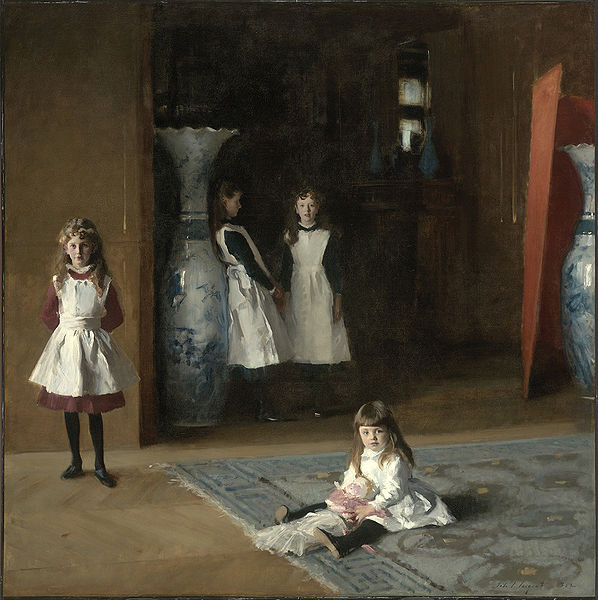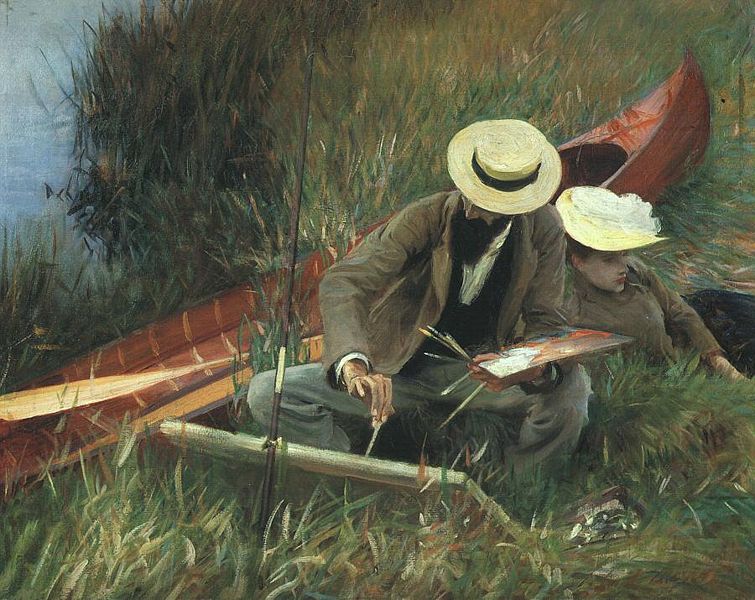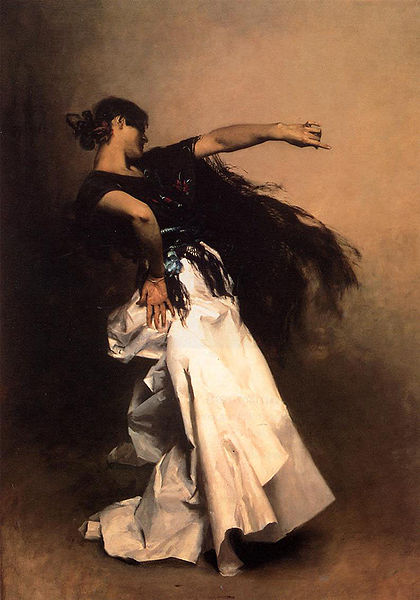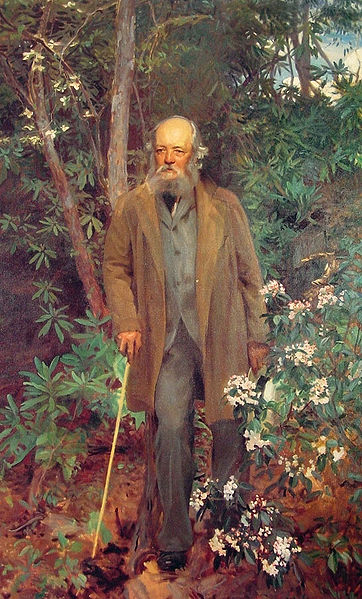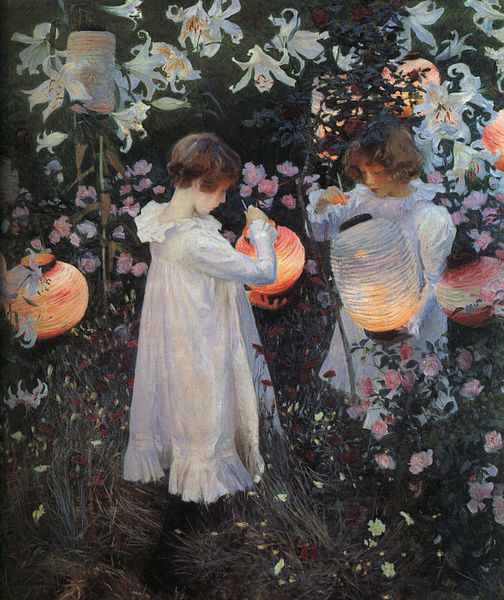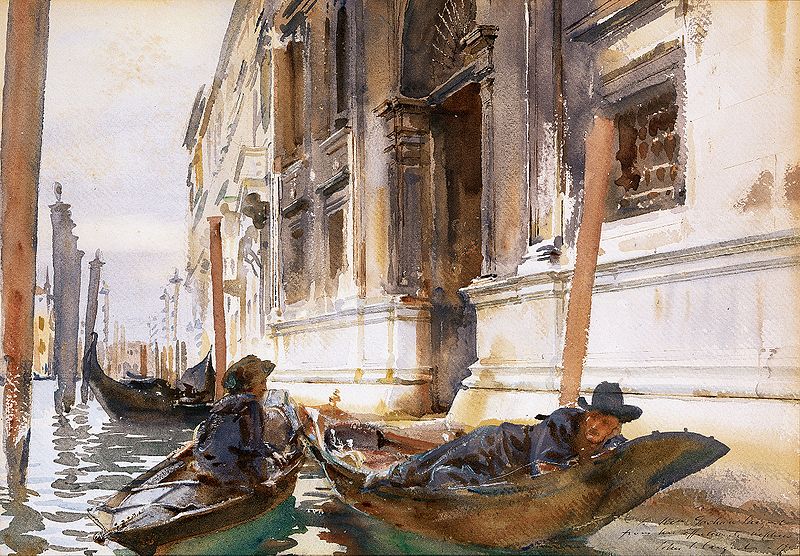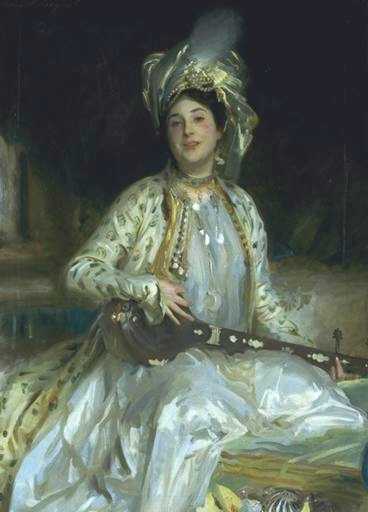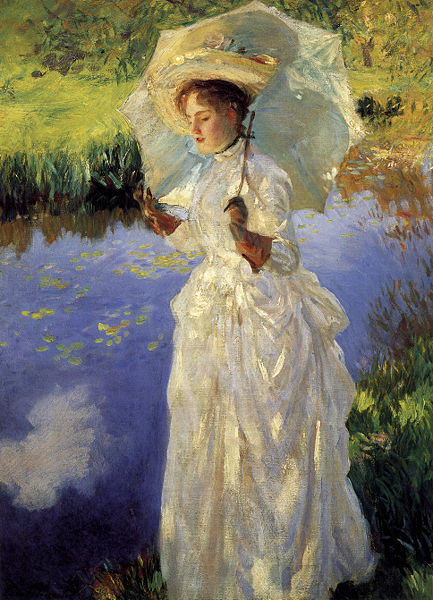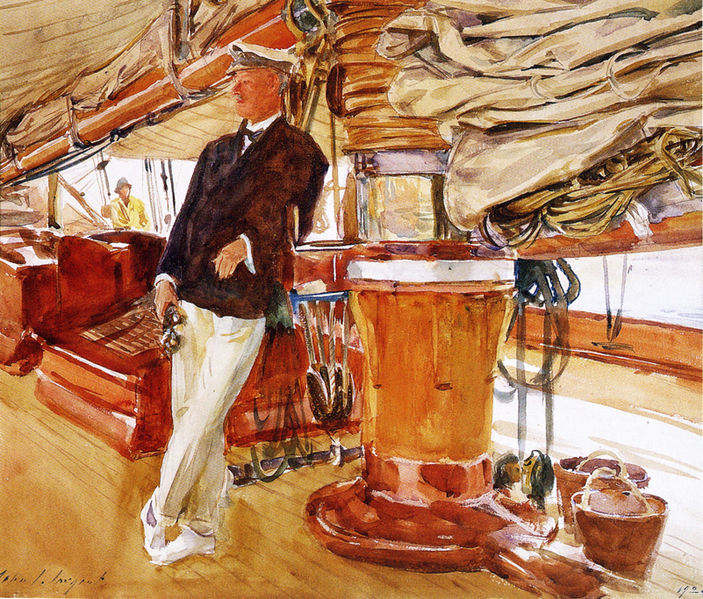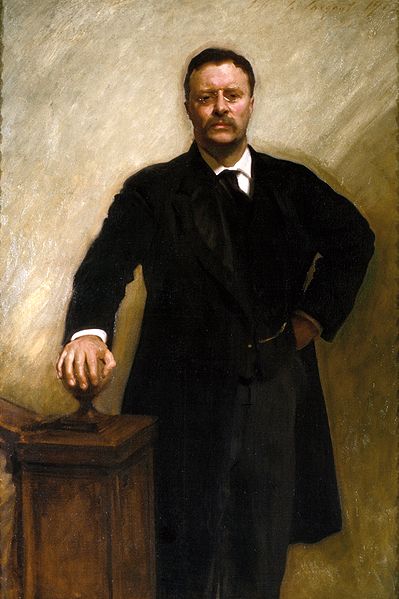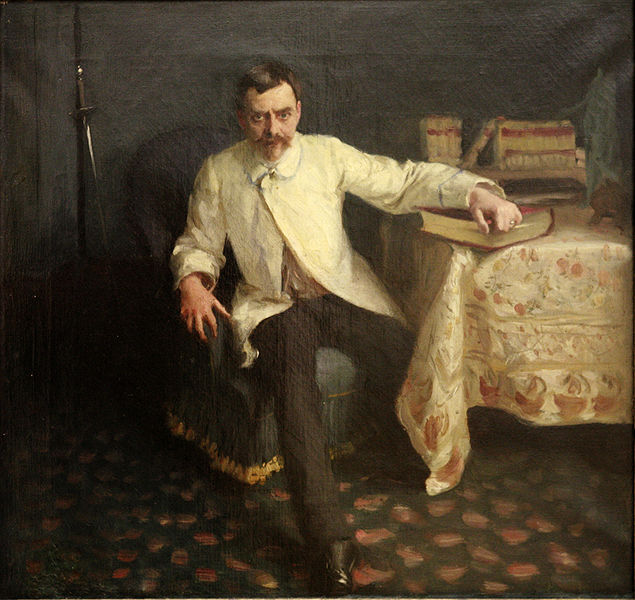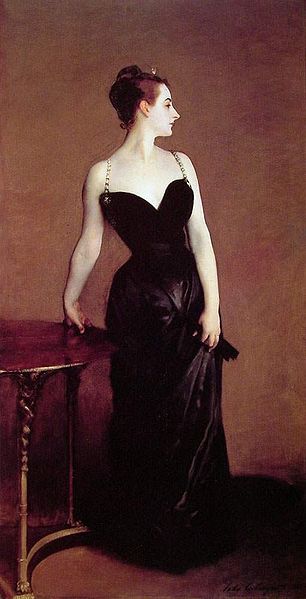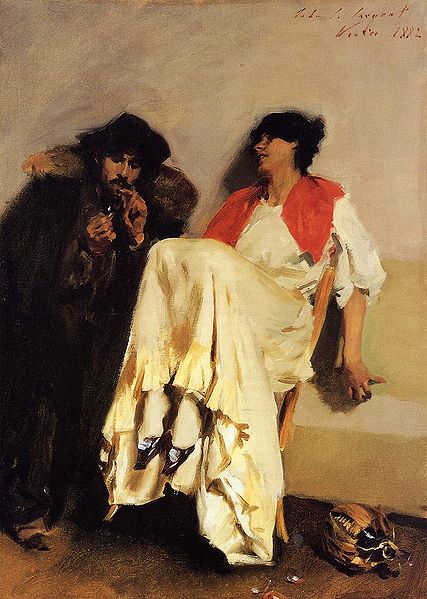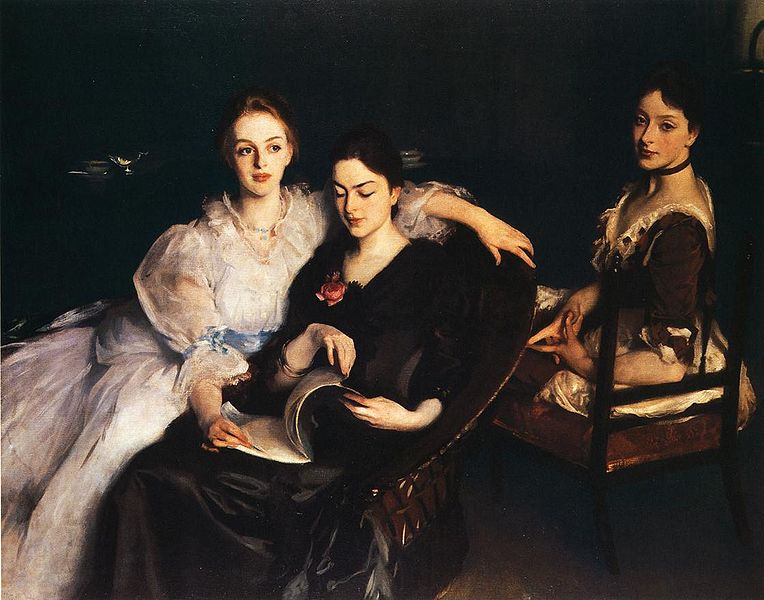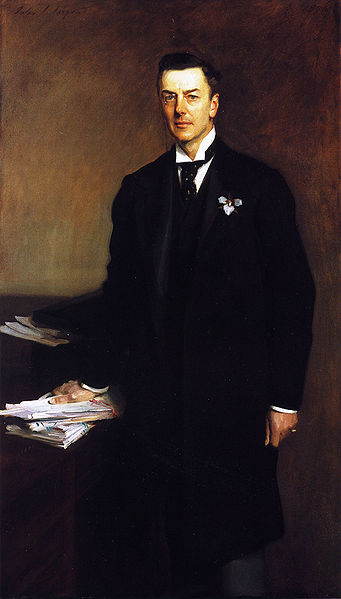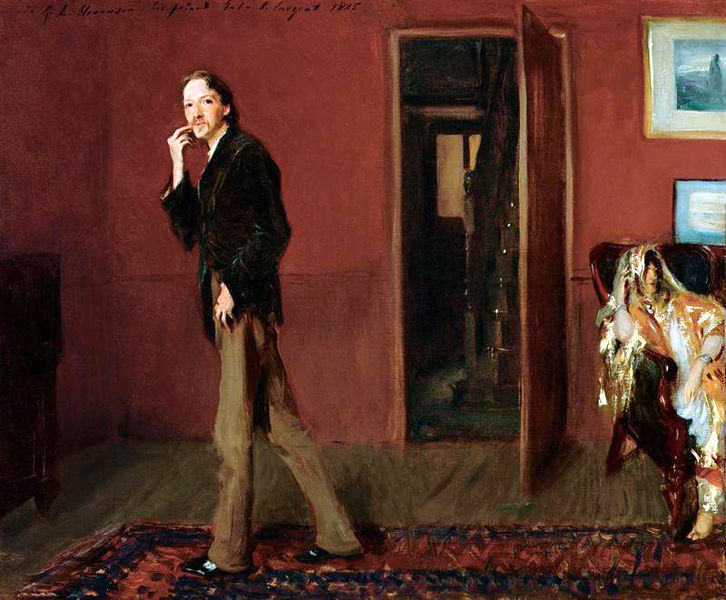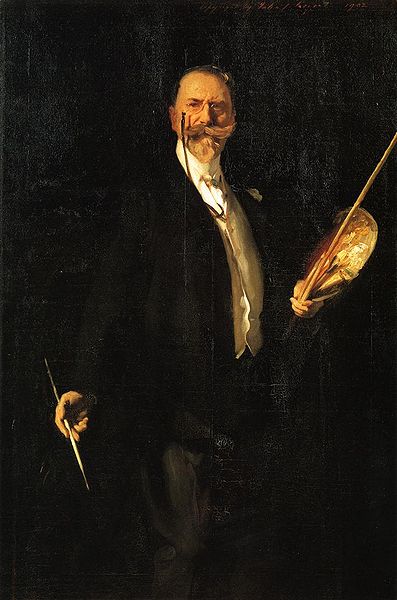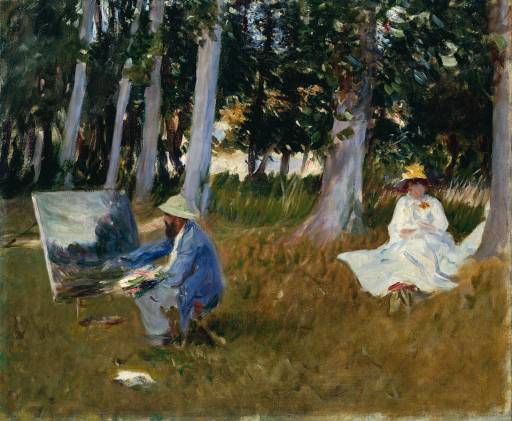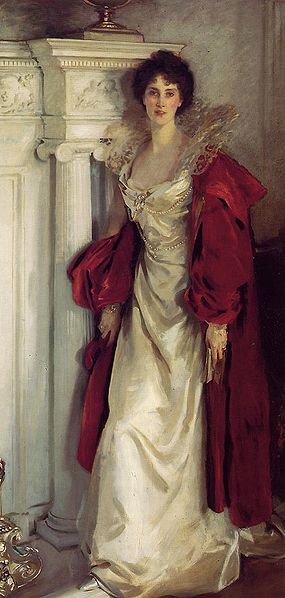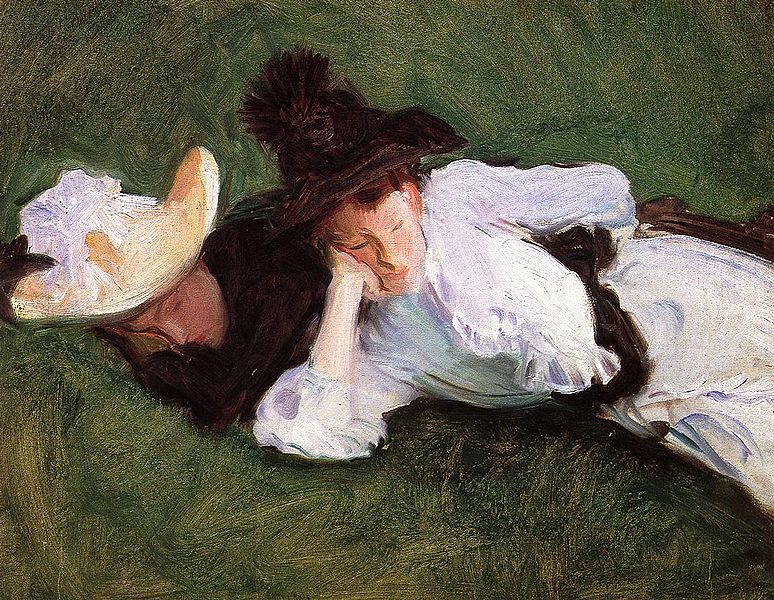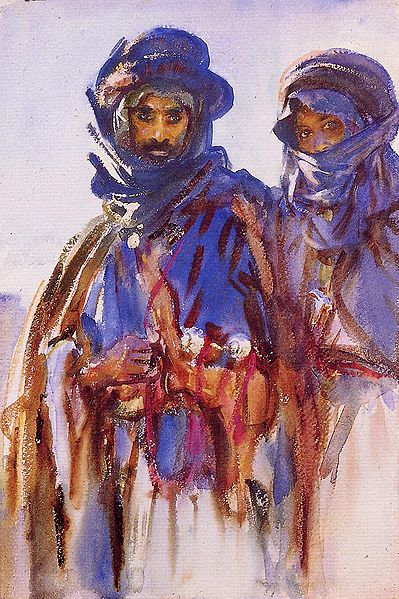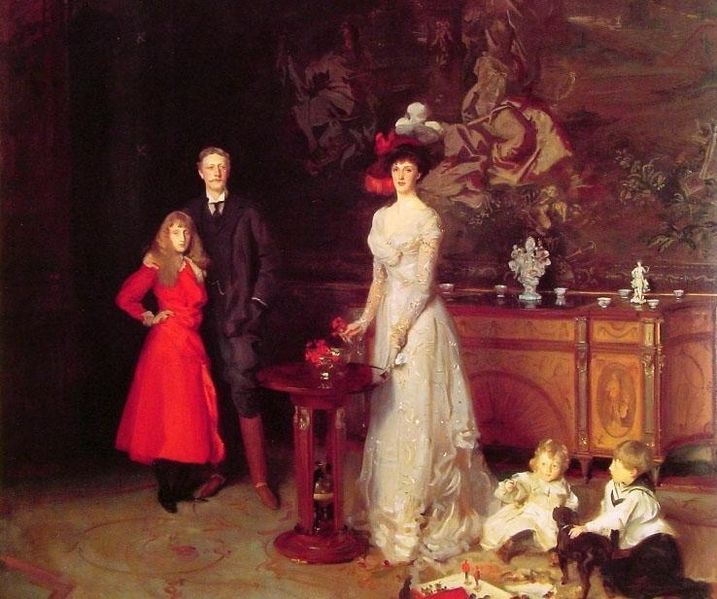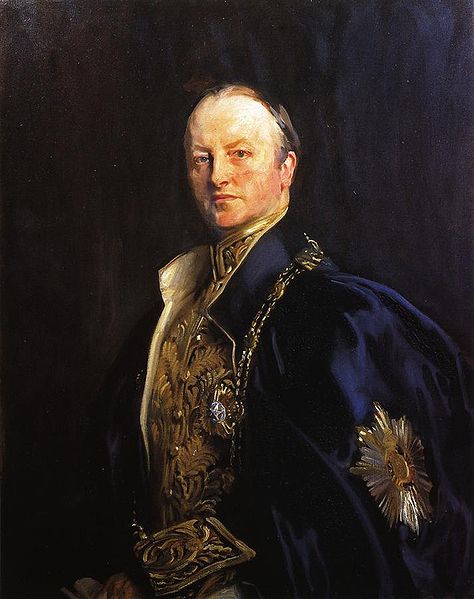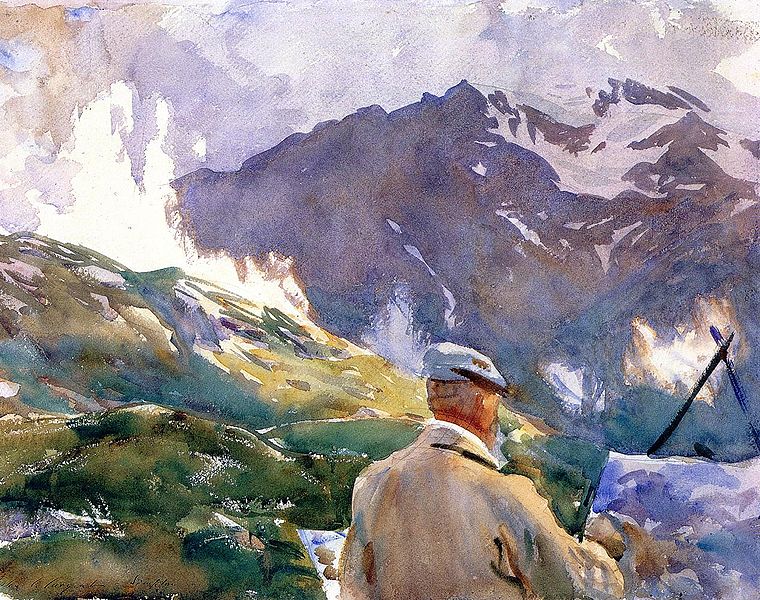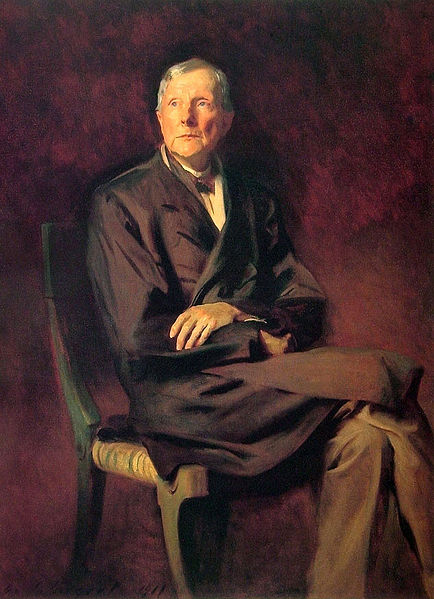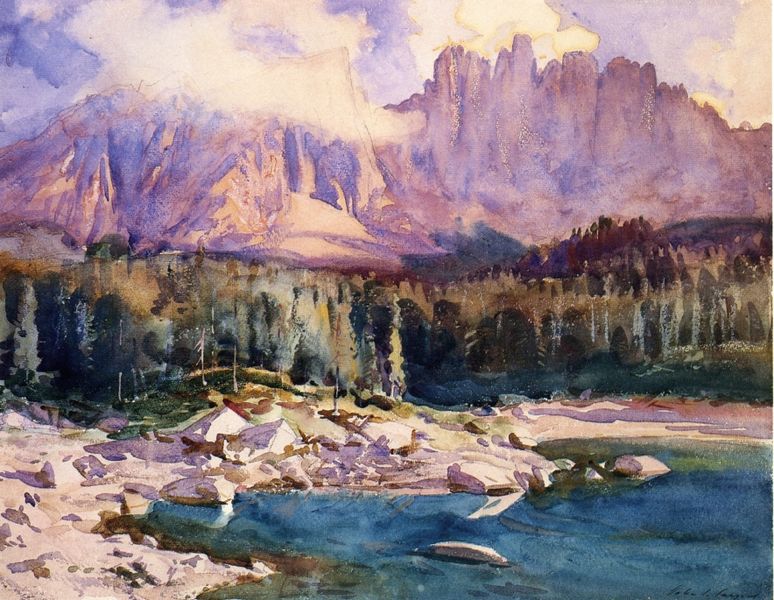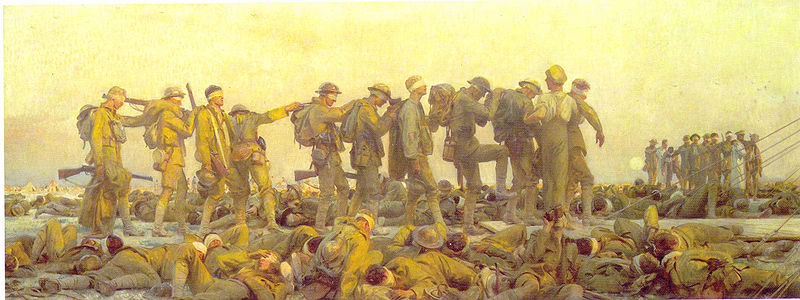<Back to Index>
- Chemist Jan Baptist van Helmont, 1579
- Painter John Singer Sargent, 1856
- President of the Reichstag Hermann Wilhelm Göring, 1893
PAGE SPONSOR
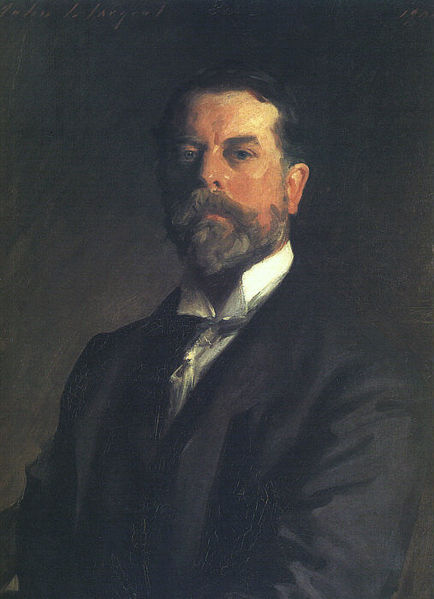
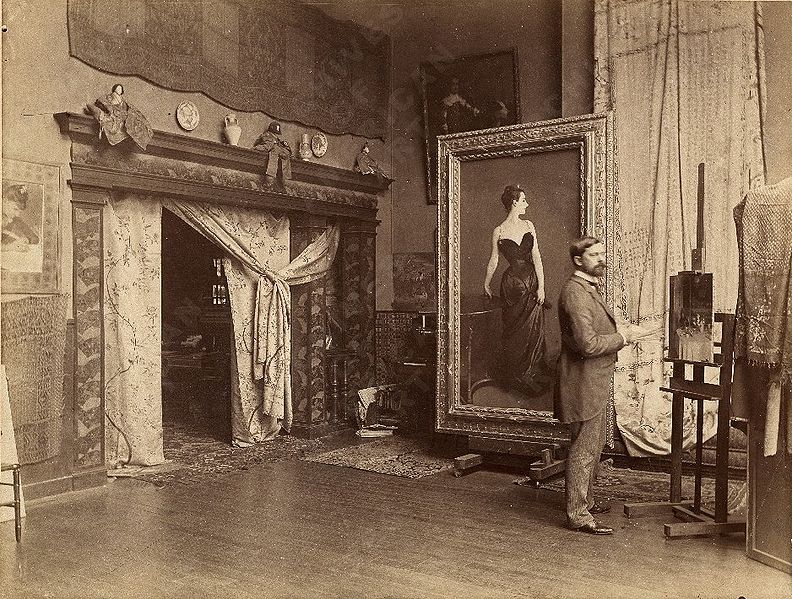
John Singer Sargent (January 12, 1856 – April 14, 1925) was an American painter, and a leading portrait painter of his era. During his career, he created roughly 900 oil paintings and more than 2,000 watercolors, as well as countless sketches and charcoal drawings. His oeuvre documents worldwide travel, from Venice to the Tyrol, Corfu, the Middle East, Montana, Maine, and Florida.
Before Sargent's birth, his father FitzWilliam (b. 1820 Gloucester, Massachusetts) was an eye surgeon at the Wills Eye Hospital in Philadelphia 1844 - 1854. After John's older sister died at the age of two, his mother Mary (née Singer) suffered a breakdown, and the couple decided to go abroad to recover. They remained nomadic expatriates for the rest of their lives. Though based in Paris, Sargent's parents moved regularly with the seasons to the sea and the mountain resorts in France, Germany, Italy, and Switzerland. While Mary was pregnant, they stopped in Florence, Italy, because of a cholera epidemic. Sargent was born there in 1856. A year later, his sister Mary was born. After her birth, FitzWilliam reluctantly resigned his post in Philadelphia and accepted his wife's entreaties to remain abroad. They lived modestly on a small inheritance and savings, living a quiet life with their children. They generally avoided society and other Americans except for friends in the art world. Four more children were born abroad, of whom only two lived past childhood.
Though his father was a patient teacher of basic subjects, young Sargent was a rambunctious child, more interested in outdoor activities than his studies. As his father wrote home, "He is quite a close observer of animated nature." His mother was quite convinced that traveling around Europe, and visiting museums and churches, would give young Sargent a satisfactory education. Several attempts to have him formally schooled failed, owing mostly to their itinerant life. Sargent's mother was a fine amateur artist and his father was a skilled medical illustrator. Early on, she gave him sketchbooks and encouraged drawing excursions. Young Sargent worked with care on his drawings, and he enthusiastically copied images from The Illustrated London News of ships and made detailed sketches of landscapes. FitzWilliam had hoped that his son's interest in ships and the sea might lead him toward a naval career.
At thirteen, his mother reported that John "sketches quite nicely, & has a remarkably quick and correct eye. If we could afford to give him really good lessons, he would soon be quite a little artist." At age thirteen, he received some watercolor lessons from Carl Welsch, a German landscape painter. Though his education was far from complete, Sargent grew up to be a highly literate and cosmopolitan young man, accomplished in art, music, and literature. He was fluent in French, Italian, and German. At seventeen, Sargent was described as "willful, curious, determined and strong" (after his mother) yet shy, generous, and modest (after his father). He was well acquainted with many of the great masters from first hand observation, as he wrote in 1874, "I have learned in Venice to admire Tintoretto immensely and to consider him perhaps second only to Michelangelo and Titian."
An attempt to study at the Academy of Florence failed as the school was re-organizing at the time, so after returning to Paris from Florence, Sargent began his art studies with Carolus - Duran. The young French portrait artist, who had a meteoric rise, was noted for his bold technique and modern teaching methods, and his influence would be pivotal to Sargent during the period from 1874 - 1878.
In 1874, on the first attempt, Sargent passed the rigorous exam required to gain admission to the École des Beaux-Arts, the premier art school in France. He took drawing classes, which included anatomy and perspective, and gained a silver prize. He also spent much time in self study, drawing in museums and painting in a studio he shared with James Carroll Beckwith. He became both a valuable friend and Sargent's primary connection with the American artists abroad. Sargent also took some lessons from Léon Bonnat. Carolus - Duran's atelier was progressive, dispensing with the traditional academic approach, which required careful drawing and underpainting, in favor of the alla prima method of working directly on the canvas with a loaded brush, derived from Diego Velázquez. It was an approach that relied on the proper placement of tones of paint. This approach also permitted spontaneous flourishes of color not bound to an under - drawing. It was markedly different from the traditional atelier of Jean Léon Gérôme, where Americans Thomas Eakins and Julian Alden Weir had studied.
Sargent was the star student in short order. Weir met Sargent in 1874 and noted that Sargent was "one of the most talented fellows I have ever come across; his drawings are like the old masters, and his color is equally fine." Sargent's excellent command of French and his superior talent made him both popular and admired. Through his friendship with Paul César Helleu, Sargent would meet giants of the art world, including Degas, Rodin, Monet, and Whistler.
Sargent's early enthusiasm was for landscapes, not portraiture, as evidenced by his voluminous sketches full of mountains, seascapes, and buildings. Carolus - Duran's expertise in portraiture finally influenced Sargent in that direction. Commissions for history paintings were still considered more prestigious, but were much harder to get. Portrait painting, on the other hand, was the best way of promoting an art career, getting exhibited in the Salon, and gaining commissions to earn a livelihood.
Sargent's first major portrait was of his friend Fanny Watts in 1877, and was also his first Salon admission. Its particularly well executed pose drew attention. His second salon entry was the Oyster Gatherers of Cançale, an impressionistic painting of which he made two copies, one of which he sent back to the United States, and both received warm reviews.
In 1879, at age 23, Sargent painted a portrait of teacher Carolus - Duran; the virtuoso effort met with public approval, and announced the direction his mature work would take. Its showing at the Paris Salon was both a tribute to his teacher and an advertisement for portrait commissions. Of Sargent's early work,Henry James wrote that the artist offered "the slightly 'uncanny' spectacle of a talent which on the very threshold of its career has nothing more to learn."
After leaving Carolus - Duran's atelier, Sargent visited Spain. There he studied the paintings of Velázquez with a passion, absorbing the master's technique, and in his travels gathered ideas for future works. He was entranced with Spanish music and dance. The trip also re-awakened his own talent for music (which was nearly equal to his artistic talent), and which found visual expression in his early masterpiece El Jaleo (1882). Music would continue to play a major part in his social life as well, as he was a skillful accompanist of both amateur and professional musicians. Sargent became a strong advocate for modern composers, especially Gabriel Fauré. Trips to Italy provided sketches and ideas for several Venetian street scenes genre paintings, which effectively captured gestures and postures he would find useful in later portraiture.
Upon his return, Sargent quickly received several portrait commissions. His career was launched. He immediately demonstrated the concentration and stamina that enabled him to paint with workman like steadiness for the next twenty-five years. He filled in the gaps between commissions with many non-commissioned portraits of friends and colleagues. His fine manners, perfect French, and great skill made him a standout among the newer portraitists, and his fame quickly spread. He confidently set high prices and turned down unsatisfactory sitters.
In the early 1880s Sargent regularly exhibited portraits at the Salon, and these were mostly full length portrayals of women, such as Madame Edouard Pailleron (1880) (done en plein - air) and Madame Ramón Subercaseaux (1881). He continued to receive positive critical notice.
Sargent's best portraits reveal the individuality and personality of the sitters; his most ardent admirers think he is matched in this only by Velázquez, who was one of Sargent's great influences. The Spanish master's spell is apparent in Sargent's The Daughters of Edward Darley Boit, 1882, a haunting interior that echoes Velázquez's Las Meninas. As in many of his early portraits, Sargent confidently tries different approaches with each new challenge, here employing both unusual composition and lighting to striking effect. One of his most widely exhibited and best loved works of the 1880s was The Lady with the Rose (1882), a portrait of Charlotte Burckhardt, a close friend and possible romantic attachment.
His most controversial work, Portrait of Madame X (Madame Pierre Gautreau) (1884) is now considered one of his best works, and was the artist's personal favorite; he stated in 1915, "I suppose it is the best thing I have done." when unveiled in Paris at the 1884 Salon, it aroused such a negative reaction that it likely prompted Sargent's move to London. Sargent's self confidence had led him to attempt another risky experiment in portraiture — but this time it unexpectedly back-fired. The painting was not commissioned by her and he pursued her for the opportunity, quite unlike most of his portrait work where clients sought him out. Sargent wrote to a mutual acquaintance:
"I have a great desire to paint her portrait and have reason to think she would allow it and is waiting for someone to propose this homage to her beauty. ...you might tell her that I am a man of prodigious talent."
It took well over a year to complete the painting. The first version of the portrait of Madame Gautreau, with the famously plunging neckline, white - powdered skin, and arrogantly cocked head, featured an off - the - shoulder dress strap which made the overall effect more daring and sensual. Sargent changed the strap to try to dampen the furor, but the damage had been done. French commissions dried up and he told his friend Edmund Gosse in 1885 that he contemplated giving up painting for music or business. Writing of the reaction of visitors, Judith Gautier observed:
"Is it a woman? a chimera, the figure of a unicorn rearing as on a heraldic coat of arms or perhaps the work of some oriental decorative artist to whom the human form is forbidden and who, wishing to be reminded of woman, has drawn the delicious arabesque? No, it is none of these things, but rather the precise image of a modern woman scrupulously drawn by a painter who is a master of his art."
Prior to the Madame X scandal of 1884, Sargent had painted exotic beauties such as Rosina Ferrara of Capri,
and the Spanish expatriate model Carmela Bertagna, but the earlier
pictures had not been intended for broad public reception. Sargent kept
the painting prominently displayed in his London studio until he sold
it to the Metropolitan Museum of Art in 1916, a few months after Gautreau's death.
Before arriving in England, Sargent began sending paintings for exhibition at the Royal Academy. These included the portraits of Dr. Pozzi at Home (1881), a flamboyant essay in red and his first full length male portrait, and the more traditional Mrs. Henry White (1883). The ensuing portrait commissions encouraged Sargent to complete his move to London in 1886. Notwithstanding the Madame X scandal, he had considered moving to London as early as 1882; he had been urged to do so repeatedly by his new friend, the novelist Henry James. In retrospect his transfer to London may be seen to have been inevitable.
English critics were not warm at first, faulting Sargent for his "clever" "Frenchified" handling of paint. One reviewer seeing his portrait of Mrs. Henry White described his technique as "hard" and "almost metallic" with "no taste in expression, air, or modeling." With help from Mrs. White, however, Sargent soon gained the admiration of English patrons and critics. Henry James also gave the artist "a push to the best of my ability."
Sargent spent much time painting outdoors in the English countryside when not in his studio. On a visit to Monet at Giverny in 1885, Sargent painted one of his most Impressionistic portraits, of Monet at work painting outdoors with his new bride nearby. Sargent is usually not thought of as an Impressionist painter, but he sometimes used impressionistic techniques to great effect. His Claude Monet Painting at the Edge of a Wood is rendered in his own version of the impressionist style. In the 1880s, he attended the Impressionist exhibitions and he began to paint outdoors in the plein - air manner after that visit to Monet. Sargent purchased four Monet works for his personal collection during that time.
Sargent was similarly inspired to do a portrait of his artist friend Paul César Helleu,
also painting outdoors with his wife by his side. A photograph very
similar to the painting suggests that Sargent occasionally used
photography as an aid to composition. Through Helleu, Sargent met and painted the famed French sculptor Auguste Rodin in 1884, a rather somber portrait reminiscent of works by Thomas Eakins. Though
the British critics classified Sargent in the Impressionist camp, the
French Impressionists thought otherwise. As Monet later stated, "He is
not an Impressionist in the sense that we use the word, he is too much
under the influence of Carolus - Duran."
Sargent's first major success at the Royal Academy came in 1887, with the enthusiastic response to
Carnation, Lily, Lily, Rose, a large piece, painted on site, of two young girls lighting lanterns in an English garden in Broadway in the Cotswolds. The painting was immediately purchased by the Tate Gallery.
His first trip to New York and Boston as a professional artist in 1887 - 88 produced over twenty important commissions, including portraits of Isabella Stewart Gardner, the famed Boston art patron. His portrait of Mrs. Adrian Iselin, wife of a New York businessman, revealed her character in one of his most insightful works. In Boston, Sargent was honored with his first solo exhibition, which presented twenty-two of his paintings.
Back in London, Sargent was quickly busy again. His working methods were by then well established, following many of the steps employed by other master portrait painters before him. After securing a commission through negotiations which he carried out, Sargent would visit the client's home to see where the painting was to hang. He would often review a client's wardrobe to pick suitable attire. Some portraits were done in the client's home, but more often in his studio, which was well stocked with furniture and background materials he chose for proper effect. He usually required eight to ten sittings from his clients, though he would try to capture the face in one sitting. He usually kept up pleasant conversation and sometimes he would take a break and play the piano for his sitter. Sargent seldom used pencil or oil sketches, and instead lay down oil paint directly. Finally, he would select an appropriate frame.
Sargent
had no assistants; he handled all the tasks, such as preparing his
canvases, varnishing the painting, arranging for photography, shipping,
and documentation. He commanded about $5,000 per portrait, or about
$130,000 in current dollars. Some American clients traveled to London at their own expense to have Sargent paint their portrait.
Around 1890, Sargent painted two daring non-commissioned portraits as show pieces — one of actress Ellen Terry as Lady MacBeth and one of the popular Spanish dancer La Carmecita. Sargent was elected an associate of the Royal Academy, and was made a full member three years later. In the 1890s, he averaged fourteen portrait commissions per year, none more beautiful than the genteel Lady Agnew of Lochnaw, 1892. His portrait of Mrs. Hugh Hammersley (Mrs. Hugh Hammersley, 1892) was equally well received for its lively depiction of one of London's most notable hostesses. As a portrait painter in the grand manner, Sargent had unmatched success; he portrayed subjects who were at once ennobled and often possessed of nervous energy. Sargent was referred to as "the Van Dyck of our times." Although Sargent was an American expatriate, he returned to the United States many times, often to answer the demand for commissioned portraits.
Sargent painted a series of three portraits of Robert Louis Stevenson. The second, Portrait of Robert Louis Stevenson and his Wife (1885), was one of his best known. He also completed portraits of two U.S. presidents: Theodore Roosevelt and Woodrow Wilson.
Asher Wertheimer, a wealthy Jewish art dealer living in London, commissioned from Sargent a series of a dozen portraits of his family, the artist's largest commission from a single patron. The paintings reveal a pleasant familiarity between the artist and his subjects. Wertheimer bequeathed most of the paintings to the National Gallery. In 1888, Sargent released his portrait of Alice Vanderbilt Shepard, great - granddaughter of Cornelius Vanderbilt. Many of his most important works are in museums in the United States.
By 1900, Sargent was at the height of his fame. Cartoonist Max Beerbohm completed one of his seventeen caricatures of Sargent, making well known to the public the artist's paunchy physique. Though only in his forties, Sargent began to travel more and to devote relatively less time to portrait painting. His An Interior in Venice (1900), a portrait of four members of the Curtis family in their elegant palatial home, Palazzo Barbaro, was a resounding success. But, Whistler did not approve of the looseness of Sargent's brushwork, which he summed up as "smudge everywhere." One of Sargent's last major portraits in his bravura style was that of Lord Ribblesdale, in 1902, finely attired in an elegant hunting uniform. Between 1900 and 1907, Sargent continued his high productivity, which included, in addition to dozens of oil portraits, hundreds of portrait drawings at about $400 each.
In 1907, at the age of fifty-one, Sargent officially closed his studio. Relieved, he stated, "Painting a portrait would be quite amusing if one were not forced to talk while working… What a nuisance having to entertain the sitter and to look happy when one feels wretched." In that same year, Sargent painted his modest and serious self - portrait, his last, for the celebrated self - portrait collection of the Uffizi Gallery in Florence, Italy.
Sargent's fame was still considerable and museums eagerly bought his works. That year he declined a knighthood and decided instead to keep his American citizenship. From 1907 on, Sargent largely forsook portrait painting and focused on landscapes in his later years. He made numerous visits to the United States in the last decade of his life, including a stay of two full years from 1915 - 1917.
By the time Sargent finished his portrait of John D. Rockefeller in 1917, most critics began to consign him to the masters of the past, "a brilliant ambassador between his patrons and posterity." Modernists treated him more harshly, considering him completely out of touch with the reality of American life and with emerging artistic trends including Cubism and Futurism. Sargent quietly accepted the criticism, but refused to alter his negative opinions of modern art. He retorted, "Ingres, Raphael and El Greco, these are now my admirations, these are what I like." In 1925, soon before he died, Sargent painted his last oil portrait, a canvas of Grace Curzon, Marchioness Curzon of Kedleston. The painting was purchased in 1936 by the Currier Museum of Art, where it is on display.
During Sargent's long career, he painted more than 2,000 watercolors, roving from the English countryside to Venice to the Tyrol, Corfu, the Middle East, Montana, Maine, and Florida. Each destination offered pictorial stimulation and treasure. Even at his leisure, in escaping the pressures of the portrait studio, he painted with restless intensity, often painting from morning until night.
His hundreds of watercolors of Venice are especially notable, many done from the perspective of a gondola. His colors were sometimes extremely vivid and as one reviewer noted, "Everything is given with the intensity of a dream." In the Middle East and North Africa Sargent painted Bedouins, goatherds, and fisherman. In the last decade of his life, he produced many watercolors in Maine, Florida, and in the American West, of fauna, flora, and native peoples.
With his watercolors, Sargent was able to indulge his earliest artistic inclinations for nature, architecture, exotic peoples, and noble mountain landscapes. And it is in some of his late works where one senses Sargent painting most purely for himself. His watercolors were executed with a joyful fluidness. He also painted extensively family, friends, gardens, and fountains. In watercolors, he playfully portrayed his friends and family dressed in Orientalist costume, relaxing in brightly lit landscapes that allowed for a more vivid palette and experimental handling than did his commissions (The Chess Game, 1906). His first major solo exhibit of watercolor works was at the Carfax Gallery in London in 1905. In 1909, he exhibited eighty-six watercolors in New York City, eighty-three of which were bought by the Brooklyn Museum. Evan Charteris wrote in 1927:
"To live with Sargent's water-colours is to live with sunshine captured and held, with the luster of a bright and legible world, ‘the refluent shade’ and ‘the Ambient ardours of the noon.’"
Though not generally accorded the critical respect given
Winslow Homer,
perhaps America's greatest watercolorist, scholarship has revealed that
Sargent was fluent in the entire range of opaque and transparent
watercolor technique, including the methods used by Homer.
All of Sargent's murals are to be found in the Boston / Cambridge area. They are in the Boston Public Library, the Museum of Fine Arts, and Harvard's Widener Library. Sargent's largest scale works are the mural decorations that grace the Boston Public Library depicting the history of religion and the gods of polytheism. They were attached to the walls of the library by means of marouflage. He worked on the cycle for almost thirty years but never completed the final mural. Sargent drew on his extensive travels and museum visits to create a dense art art historial melange. The murals were restored in 2003 - 2004.
Upon his return to England in 1918 after a visit to the United States, Sargent was commissioned as a war artist by the British Ministry of Information. In his large painting Gassed and in many watercolors, he depicted scenes from the Great War.
From
1895 through 1919, Sargent had worked on a series of murals with a
religious theme, known as "The Triumph of Religion." It was intended to
show religion's (and society's) progress, from pagan superstition up
through the ascension of Christianity, concluding with a painting
depicting Jesus delivering the Sermon on the Mount. But Sargent's late
1919 paintings of "The Church" and "The Synagogue" inspired a debate
about whether the artist had represented Judaism in a stereotypic, or
even an anti-Semitic, manner. Drawing upon iconography that was used in
medieval paintings, Sargent portrayed Judaism and the synagogue as a
blind, ugly hag, and Christianity and the church as a lovely, and
radiant young woman. He also failed to understand how these
representations might be problematic for the Jews of Boston; he was
both surprised and hurt when the paintings were criticized (Promey).
Members of the Jewish community found the paintings objectionable since
they seemed to show Judaism defeated, and the triumph of religion was
thus the triumph of Christianity ("New Painting At Public Library" 48).
Even many non-Jews found the paintings uncomfortable, and questioned
whether they were suitable for display at the Boston Public Library.
Wrote the Boston Herald's art critic, Frederick William Coburn, "“If
one were an orthodox (sic) Jew, a rabbi or a cantor, it might be a
little distasteful to have this middle-age fashion of depreciating his
ancient religion in a building supported by public taxation” (quoted by
Joselit).
The Boston newspapers also followed the controversy, noting that while
many rabbis and Jewish organizations (and a few Christian groups as
well) found the paintings offensive, not everyone agreed with Coburn's
views. In the end, Sargent abandoned his plan to finish the mural, and
the controversy eventually died down. However, for many years
afterward, the paintings were not displayed. This changed in 2003 - 2004,
when the Boston Public Library restored Sargent's murals, including the
two controversial panels, making them available to audiences once again.
Sargent was a life long bachelor who surrounded himself with family and friends. Among the artists with whom Sargent associated were Dennis Miller Bunker, James Carroll Beckwith, Edwin Austin Abbey (who also worked on the Boston Public Library murals), Francis David Millet, Wilfrid de Glehn, Jane Emmet de Glehn and Claude Monet, whom Sargent painted. Sargent developed a life long friendship with fellow painter Paul César Helleu, whom he met in Paris in 1878 when Sargent was 22 and Helleu was 18. Sargent's friends and supporters included Henry James, Isabella Stewart Gardner (who commissioned and purchased works from Sargent, and sought his advice on other acquisitions), and Edward VII.
Sargent was extremely private regarding his personal life, although the painter Jacques - Émile Blanche, who was one of his early sitters, said after his death that Sargent's sex life "was notorious in Paris, and in Venice, positively scandalous. He was a frenzied bugger." The truth of this may never be established. Some scholars have suggested that Sargent was homosexual. He had personal associations with Prince Edmond de Polignac and Count Robert de Montesquiou. His male nudes reveal complex and well considered artistic sensibilities about the male physique and male sensuality; this can be particularly observed in his portrait of Thomas E. McKeller, but also in Tommies Bathing, nude sketches for Hell and Judgement, and his portraits of young men, like Bartholomy Maganosco and Head of Olimpio Fusco. However, there were many friendships with women, as well, and a similar suppressed sensualism informs his female portrait and figure studies (notably Egyptian Girl, 1891). Art historian Deborah Davis suggests that Sargent's interest in women he considered exotic, Rosina Ferrara, Amélie Gautreau and Judith Gautier, was prompted by infatuation that transcended aesthetic appreciation. The likelihood of an affair with Louise Burkhardt, the model for Lady with the Rose, is accepted by Sargent scholars.
In 1922 John Singer Sargent founded New York City's Grand Central Art Galleries together with Edmund Greacen, Walter Leighton Clark, and others. The Galleries' goal was to "give a broader field to American art; to exhibit in a larger way to a more numerous audience, not in New York alone but throughout the country, thus displaying to the world the inherent value which our art undoubtedly possesses."
Through the support of Alfred Holland Smith, president of the New York Central Railroad, the top of the Grand Central Terminal was made available. The Galleries extended over most of the terminal's sixth floor, 15,000 square feet (1,400 m2), and offered eight main exhibition rooms, a foyer gallery, and a reception area. A total of 20 display rooms were to be created for what was intended to be "the largest sales gallery of art in the world."
The Grand Central Art Galleries officially opened on March 23, 1923. The event featured paintings by Sargent, Charles W. Hawthorne, Cecilia Beaux, Wayman Adams, and Ernest Ipsen. Sculptors included Daniel Chester French, Herbert Adams, Robert Aitken, Gutzon Borglum, and Frederic MacMonnies. In keeping with the founders' conception of the Galleries as a commercial as well as artistic organization, the majority of the works on display were for sale. Prices ranged from $100 to $10,000, the most expensive one being by Hawthorne; Sargent's contribution was valued at $5,000.
Sargent actively participated in the Grand Central Art Galleries and their academy, the Grand Central School of Art, until his death in 1925. Three years later the Galleries organized a posthumous exhibition of previously unseen sketches and drawings from throughout his career. The materials were found in the artist's London studio after his death, and Sargent's sisters chose Walter Leighton Clark to go through them. Clark selected several hundred works for the exhibition. They included early drawings made by Sargent when he was a teenager and experiments with watercolors from 1872, as well as preparatory sketches for celebrated paintings such as Madame X, now in the Metropolitan Museum of Art, and Gassed, now in the National Gallery in London.
The Grand Central Art Galleries remained in Grand Central Terminal until 1958, when they moved to the second floor of the Biltmore Hotel. They remained at the Biltmore for 23 years, until it was converted into an office building. The Galleries then moved to 24 West 57th Street, where they remained until they ceased activity in the early 1990s.
In a time when the art world focused, in turn, on Impressionism, Fauvism, and Cubism, Sargent practiced his own form of Realism, which made brilliant references to Velázquez, Van Dyck, and Gainsborough. His seemingly effortless facility for paraphrasing the masters in a contemporary fashion led to a stream of commissioned portraits of remarkable virtuosity (Arsène Vigeant, 1885, Musées de Metz; Mr. and Mrs. Isaac Newton Phelps - Stokes, 1897, Metropolitan Museum of Art, New York) and earned Sargent the moniker, "the Van Dyck of our times."
Still, during his life his work engendered critical responses from some of his colleagues: Camille Pissarro wrote "he is not an enthusiast but rather an adroit performer," and Walter Sickert published a satirical turn under the heading "Sargentolatry." By the time of his death he was dismissed as an anachronism, a relic of the Gilded Age and out of step with the artistic sentiments of post-World War I Europe. Elizabeth Prettejohn suggests that the decline of Sargent's reputation was due partly to the rise of anti-Semitism, and the resultant intolerance of 'celebrations of Jewish prosperity.' It has been suggested that the exotic qualities inherent in his work appealed to the sympathies of the Jewish clients whom he painted from the 1890s on.
Nowhere is this more apparent than in his portrait Almina, Daughter of Asher Wertheimer (1908), in which the subject is seen wearing a Persian costume, a pearl encrusted turban, and strumming an Indian sarod, accoutrements all meant to convey sensuality and mystery. If Sargent used this portrait to explore issues of sexuality and identity, it seems to have met with the satisfaction of the subject's father, Asher Wertheimer, a wealthy Jewish art dealer.
Foremost of Sargent's detractors was the influential English art critic Roger Fry, of the Bloomsbury Group, who at the 1926 Sargent retrospective in London dismissed Sargent's work as lacking aesthetic quality: "Wonderful indeed, but most wonderful that this wonderful performance should ever have been confused with that of an artist." And, in the 1930s, Lewis Mumford led a chorus of the severest critics: "Sargent remained to the end an illustrator… the most adroit appearance of workmanship, the most dashing eye for effect, cannot conceal the essential emptiness of Sargent's mind, or the contemptuous and cynical superficiality of a certain part of his execution."
Part of Sargent's devaluation is also attributed to his expatriate life, which made him seem less American at a time when "authentic" socially - conscious American art, as exemplified by the Stieglitz circle and by the Ashcan School, was on the ascent.
Despite a long period of critical disfavor, Sargent's popularity has increased steadily since the 1950s. In the 1960s, a revival of Victorian art and new scholarship directed at Sargent strengthened his reputation. Sargent has been the subject of large scale exhibitions in major museums, including a retrospective exhibition at the Whitney Museum of American Art in 1986, and a 1999 "blockbuster" travelling show that exhibited at the Museum of Fine Arts, Boston, the National Gallery of Art Washington, and the National Gallery, London.
In 1986, Andy Warhol commented that Sargent "made everybody look glamorous. Taller. Thinner. But they all have mood, every one of them has a different mood." Also around that time, critic Robert Hughes praised Sargent as "the unrivaled recorder of male power and female beauty in a day that, like ours, paid excessive court to both."
John Singer Sargent is interred in Brookwood Cemetery near Woking, Surrey.
Portrait of Robert Louis Stevenson and his Wife sold in 2004 for $US 8.8 million to Las Vegas casino mogul Steve Wynn to be installed at his newest casino, Wynn Las Vegas. In December 2004, Group with Parasols (A Siesta) (1905)
sold for $US 23.5 million, nearly double the Sotheby's estimate of $12
million. The previous highest price for a Sargent painting was $US 11
million.
